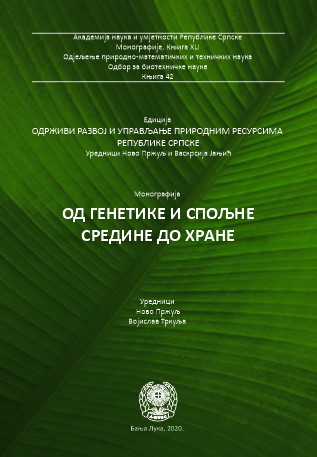The importance of preserving biodiversity for sustainable utilization of plant genetic resources
DOI:
https://doi.org/10.7251/EORU2001035JKeywords:
Biodiversity, plant genetic resources, preservation, sustainable utilizationAbstract
The life of a modern man is completely dependent on natural resources that mankind has been exploiting for a long period to a degree that far exceeds the limits of their sustainability. While the needs for the resources are rising rapidly over the last decades, their available quantities are rapidly decreasing. Growing deficiency of natural resources is becoming one of the biggest global challenges. Although the exploitation of natural resources and the preservation of biodiversity are the core of the two opposing processes, common to both is that they are the consequence of man's need for survival. Biodiversity on the planet today is seriously endangered due to the disappearance of species that is much faster and frequent than before. According to some estimates, every fourth species of mammals is threatened with a real danger of extinction, while about half of the plant species are before extinction. During long evolutionary history, the living world was constantly under numerous and enormous environmental pressures that, thanks to its genetic potential, managed to overcome. Given that today's environment is changing much faster than it was in the past, it is not known whether living beings possess an adaptive capacity that will be sufficient to adapt to new conditions. There are more and more scientific evidence that from the period of disappearance of dinosaurs 65 million years ago this is the era of the greatest extinction of species. Out of all biodiversity elements, genetic resources are the most exposed to unfavourable factors (climate change, new diseases and pests, industry, the spread of cities and settlements, intense infrastructure interventions, etc.). There are many facts that indicate that climate change in the future will increasingly affect the survival of plant species. The ever-present loss of germplasm and habitat requires much greater mobility in their protection. It is therefore necessary to take urgent steps to preserve these resources while the genetic diversity they possess is still available. Any further postponement of conservation would lead to even more pronounced disturbance of biodiversity, and this activity would be more uncertain in the future. For these reasons it is necessary to develop acceptable protection programs as soon as possible that will offer answers on where and how to protect the existing diversity. Because of their actual or potential value, this should be urgently done, as this would ensure long-term stable production of quality food and plant products, but also the risks associated with intensive plant production systems would be mitigated. In addition, increasing the diversity of cultivated crops would ensure continuous crop cultivation and improved food safety. Crop improvement, especially under climatic conditions, will increasingly be based on the diversity of plant genetic resources that have been relatively poorly used and inadequately preserved so far. In order to ensure sustainable food supply, it will be necessary to create new varieties with increased tolerance to adverse environmental conditions. Due to the richness of genetic diversity, plant genetic resources show very high adaptability in a fairly wide range of ecological conditions. Therefore, in order to preserve the adaptability of cultivated crops and future food safety, these resources will be needed more than ever. It seems that mankind finally realized that its survival on Earth is irrevocably conditioned by the preservation of biodiversity. Due to these reasons, in recent years increased social attention has been devoted to activities of raising public awareness on the importance of preserving biodiversity and the impact it has on the well-being of the human population. Sustainable use of agricultural diversity represents the exploitation of biological diversity to an extent and in a manner that does not cause biodiversity degradation. Such an approach would make possible to create a better and more equitable world in which economic, social, cultural and environmental factors would be in full balance. Preservation and sustainable use of agrobiodiversity must be based on sustainable agricultural practices that integrate development and environmental problems into one whole. The key to the preservation of biological diversity lies in the hands of science, which besides new knowledge on the living world must offer concrete projects for the protection and improvement of biodiversity. For preserving biodiversity will not only be sufficient to determine the criteria of vulnerability and listing of endangered species, but also establishment of effective management concept based on the rational use of biodiversity in a manner and extent that does not cause further deterioration. Preservation and sustainable use of genetic resources and traditional knowledge related to their use is a long-term need that goes beyond national interests.
